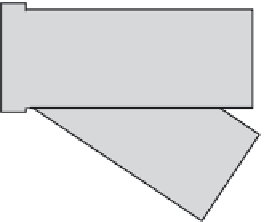Environmental Engineering Reference
In-Depth Information
figure 4.38 A common strainer.
collect. A blow-out connection may be provided in the end cap to flush
the strainer. The blow-out plug can be removed, and pressure in the line
can be used to blow the fixture clean.
Caution:
Before removing the blow-out plug, the valve system must be
locked out/tagged out first.
4.14.3 filters
The purpose of any filter is to reduce or remove impurities or con-
taminants from a fluid (liquid or gas) to an acceptable or predetermined
level. This is accomplished by passing the fluid through some kind of
porous barrier. Filter cartridges have replaceable elements made of
paper, wire cloth, nylon cloth, or fine-mesh nylon cloth between layers
of coarse wire. These materials filter out unwanted contaminants that
collect on the entry side of the filter element. When clogged, the element
is replaced. Most filters operate in two ways: (1) they cause the fluid to
make sharp changes in direction as it passes through (this is important,
because the larger particles are too heavy to change direction quickly),
or (2) they contain some kind of barrier that will not let larger contami-
nants pass.
4.14.4 Traps
Traps
,
used in steam processes, are automatic valves that release
condensate (condensed steam) from a steam space while preventing the
loss of live steam. Condensate is undesirable because water produces
rust, and water plus steam leads to water hammer. In addition, steam
traps remove air and noncondensate from the steam space. The opera-
tion of a trap depends on what is called
differential pressure
(or delta-P),
measured in psi. Differential pressure is the difference between the inlet
and outlet pressures. A trap will not operate correctly at a differential
pressure higher than the one for which it was designed.
Many types of steam traps are available because of their many differ-
ent types of applications. Each type of trap has a range of applications for
which it is best suited; for example, thermostatic and float-and-thermo-
static are two general types of traps.
Thermostatic traps
have a corrugated
bellows-operating element that is filled with an alcohol mixture that has a






























